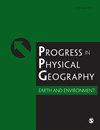利用多尺度地理加权回归模型探索三维城市景观模式与 PM2.5 污染之间的关系
IF 3.6
3区 地球科学
Q2 GEOGRAPHY, PHYSICAL
Progress in Physical Geography-Earth and Environment
Pub Date : 2024-03-25
DOI:10.1177/03091333241241458
引用次数: 0
摘要
细颗粒物(PM2.5)是空气污染的主要来源,对人类健康造成严重影响。城市三维景观格局会极大地影响 PM2.5 的扩散和排放。然而,关于三维城市景观格局与不同季节 PM2.5 污染之间关系的研究仍然不足。本研究利用遥感估算的地面空气污染物和精细尺度的建筑信息,采用多尺度地理加权回归模型来探讨这种关系。我们选择了华中地区最大的城市武汉作为研究区域。研究结果表明,三维城市景观格局对 PM2.5 污染的影响方向、程度和规模在不同季节存在差异。在建筑高度方面,建筑高度标准偏差与 PM2.5 全年呈显著正相关。在建筑密度方面,建筑数量密度总体上与 PM2.5 呈显著正相关,冬季和秋季的带宽小于春季和夏季。建筑平面面积分数对 PM2.5 既有正向影响,也有负向影响,这取决于季节和地点。其带宽从春季到冬季逐渐增加,影响范围从局部到区域。在建筑体积方面,容积率在冬季和秋季与 PM2.5 呈显著负相关,并且发现了局部效应,尤其是在冬季。这项研究的结果为城市规划和政策制定提供了实际意义,以缓解快速城市化地区的 PM2.5 污染。本文章由计算机程序翻译,如有差异,请以英文原文为准。
Exploring the relationships between 3D urban landscape patterns and PM2.5 pollution using the multiscale geographic weighted regression model
Fine particulate matter (PM2.5 ) is a major source of air pollution and exerts serious impacts on human health. The 3D urban landscape patterns can significantly affect the diffusion and emissions of PM2.5 . However, studies on the relationships between 3D urban landscape patterns and PM2.5 pollution across different seasons remain understudied. With the ground-level air pollutants estimated by the remote sensing and fine-scale building information, this study applied the multiscale geographically weighted regression model to explore such relationships. Wuhan, the largest metropolis in Central China, was selected as the study area for the application of our methodology. The results showed that the direction, degree, and scale of the effect of 3D urban landscape patterns on PM2.5 pollution varied across seasons. For building height, the standard deviation of building height had a significant positive correlation with PM2.5 all year round. For building density, the building count density showed a significant positive correlation with PM2.5 in general, with the bandwidth in winter and autumn smaller than in spring and summer. The building plan area fraction exerted both positive and negative influences on PM2.5 , dependent on season and location. The bandwidth of it gradually increased from spring to winter, with the effect changing from local to regional scale. For building volume, the floor area ratio showed a significant negative correlation with PM2.5 in winter and autumn, and a localized effect was found, especially in winter. The findings of this study provide practical implications for urban planning and policy making to mitigate PM2.5 pollution in the rapidly urbanizing regions.
求助全文
通过发布文献求助,成功后即可免费获取论文全文。
去求助
来源期刊
CiteScore
7.20
自引率
5.10%
发文量
53
审稿时长
>12 weeks
期刊介绍:
Progress in Physical Geography is a peer-reviewed, international journal, encompassing an interdisciplinary approach incorporating the latest developments and debates within Physical Geography and interrelated fields across the Earth, Biological and Ecological System Sciences.

 求助内容:
求助内容: 应助结果提醒方式:
应助结果提醒方式:


